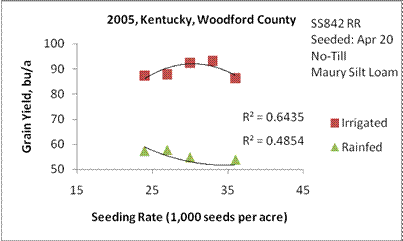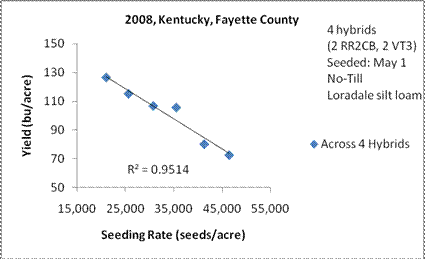Corn Seeding Rates, 2004-2008: Research Update
Chad Lee, Grain Crops Extension
Plant and Soil Sciences, University of Kentucky
Last updated: April 15, 2009
Several seeding rate studies in corn were conducted over the last five years to determine if seeding rates recommendations for corn should be changed. Various seeding rates spanned 20,000 to 45,000 seeds/acre. Studies were conducted at the Woodford County Animal Research Center (ARC) on a Maury silt loam from 2003 through 2007. Both rainfed and irrigated corn was grown. The irrigation system was a subsurface drip irrigation system, buried 15 inches deep and 5 feet apart. The subsurface system was being tested for its applicability to Kentucky no-till systems. Another study was conducted on seeding rates at the Spindletop Research Farm near Lexington, KY on a Loradale silt loam in 2008.
Each test plot was 10 feet wide by 100 feet long and each seeding rate was repeated five times at ARC. For Spindletop, each plot was 10 feet by 40 feet and each seeding rate was repeated three times for each hybrid. Hybrids used at the ARC had performed well in the University of Kentucky corn hybrid performance test. Hybrids used at Spindletop were selected based on their genetics and two pairs of "sister hybrids" were evaluated (a pair consisted of one hybrid with RR2CB and the other with VT3).
In 2004, yields reach 220 bu/acre and began to level out near 30,000 seeds per acre for both irrigated and non-irrigated plots (Figure 1). In 2005, yields reached only 95 bu/acre for irrigated corn and topped out at 30,000 seeds/acre (Figure 2). Not enough water was applied through the irrigation system in 2005. In subsequent testing, the subsurface irrigation system needed about 2 inches of water applied for every 1 inch of water with an overhead sprinkler system. For the non-irrigated (rainfed) study, highest yields were only 60 bu/acre and the lowest seeding rate 24,000 seeds/acre was optimal.
For 2006, highest yields for irrigated corn were near 220 bu/acre and occurred at seeding rates of 30,000 and 36,000 seeds/acre. For the rainfed corn, highest yields were about 190 bu/acre and achieved with both 30,000 and 36,000 seeds/acre (Figure 3). For 2007, highest yields of about 200 bu/acre were achieved in irrigated corn with 40,000 seeds/acre (Figure 4). Regression analysis indicated that the peak of yield had not been reached. For rainfed corn, however, the highest yield of about 170 bu/acre was reached with 30,000 seeds/acre.
For 2008, the corn at Woodford County was planted late, due to the wet spring. A timely planting (May 1) occurred for four hybrids at Spindletop Farm in Fayette County. Two of the four hybrids were "RR2CB" hybrids and two were "VT3" hybrids. Highest yields were only 130 bu/acre, which occurred at 20,000 seeds/acre. Yields declined rapidly for higher seeding rates.
Overall, hybrids were grown at various seeding rates for five years. During those five years, water was extremely limiting twice (2005 and 2008). When water was extremely limiting, the lowest seeding rate yielded the best. When water was not limiting (2004, 2006 and 2007, irrigated conditions) 30,000 seeds/acre resulted in the highest yield two years while 40,000 seeds/acre resulted in the highest yield another.
Partial returns were calculated for 2004, 2006 and 2007, years when rainfall was adequate and yields were acceptable. Partial returns were the gross return ($/bu * bu/acre) minus seed costs ($/80,000 seeds minus seeds/acre). Partial returns did not account for harvest costs, drying, trucking or irrigation. Harvest, trucking and drying should be included in the costs to get a better estimate of partial returns. Assuming that seed costs $200 per 80,000 units (1 bag) and corn commodity prices are $4.226/bu, partial returns are greatest near 30,000 seeds per acre for rainfed corn and near 33,000 seeds per acre for irrigated corn (Figure 6).
For non-irrigated (or rainfed) corn, University of Kentucky currently recommends seeding up to 30,000 seeds/acre on better soils. Evidence from the last five years supports that recommendation. For producers that have irrigation, 33,000 to 34,000 seeds per acre seem appropriate. If a field has historically poor yields, then lower seeding rates should be used. If a field has historically high yields, then higher seeding rates could be worthwhile.
Farmers are constantly questioning seeding rates, and there may be some fields with exceptionally high yield histories that could benefit from higher seeding rates. If you believe you have such a field, then conduct a good on-farm study to see how high you can go. Include at least four seeding rates and include a range below and above where you think you need to be. Also, spread the range in rates in increments of 5,000. For example, you think your seeding rate should be 35,000 seeds per acre. Include a test with 30,000, 35,000 and 40,000 and 45,000 seeds per acre. If possible, repeat each of those seeding rates several times in the field. Use of GPS guidance systems and variable rate planters can make this process very simple. Keep good records and take a stand count when the corn has about three or four leaves. Use your calibrated yield monitor on your combine to record the yields.

Figure 1. Corn yield response to seeding rates at Woodford Animal Research Center, 2004.

Figure 2. Corn yield response to seeding rates at Woodford Animal Research Center, 2005.

Figure 3. Corn yield response to seeding rates at Woodford Animal Research Center, 2006.

Figure 4. Corn yield response to seeding rates at Woodford Animal Research Center, 2007.

Figure 5. Corn yield response to seeding rates at Spindletop Research Farm, near Lexington, KY, 2008.

Figure 6. Partial returns* calculated and predicted for studies conducted 2004, 2006 and 2007 at Woodford County Animal Research Center, University of Kentucky.
*Partial return calculated as the gross return ($/bu * bushels/acre) minus seed cost ($/80,000 seeds * seeds/acre). Harvesting, drying and trucking were not factored into this example. Also, irrigation costs were not factored into this example. The solid line is the calculated response curve. The blue dash lines are the 95% confidence bands and the red dotted lines are the 95% predicted lines.
